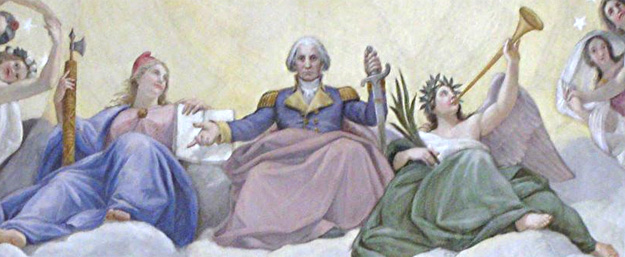
The Apotheosis of Washington (detail), Constantino Brumidi, 1865, United States Capitol Building rotunda.
I watched an interesting show last night, Secret America on Discovery, and learned some interesting things. One of them was that there is a large fresco painted on the inside of the dome of the rotunda of the United States Capitol Building. It is called “The Apotheosis of Washington” and was painted by an Italian Painter, Constantino Brumidi, in 1865 for the sum of $40,000.
What is interesting is what was painted in this profound location. The apotheosis of Washington literally means the deification of President George Washington, or the exaltation of Washington to the status of a god. Wikipedia describes:
The Apotheosis of Washington depicts George Washington ascending to the heavens and becoming a god (apotheosis). Washington, the first U.S. president and commander-in-chief of the Continental Army during the American Revolutionary War, is allegorically represented, surrounded by figures from classical mythology. Washington is draped in purple, a royal color, with a rainbow arch at his feet, flanked by the goddess Victory (draped in green, using a horn) to his left and the goddess Liberty to his right. Liberty wears a red cap, symbolizing emancipation, from a Roman tradition where sons leaving the home would be given a red cap. She holds a fasces in her right hand and an open book in the other.[1]
Wikipedia also describes the term apotheosis:
Apotheosis (from Greek ἀποθεόω, apotheoō “to deify”) refers to the exaltation of a subject to divine level. The term has meanings in theology, where it refers to a belief, and in art, where it refers to a genre.
In theology the term apotheosis refers to the idea that an individual, group, or locale has attained godlike stature. In art the term refers to the treatment of any subject (a figure, motif, convention or melody) in a particularly grand or exalted manner.[2]
The full painting really is quite stunning. You can see it here. George Washington is depicted sitting in the clouds, amongst the gods, making gestures common in divine figures. The Architect of the Capitol government webpage notes:
The word “apotheosis” in the title means literally the raising of a person to the rank of a god, or the glorification of a person as an ideal; George Washington was honored as a national icon in the nineteenth century.[3]
It’s not only the Mormons who have thoughts about the divinization of mankind, but such a theme is even portrayed of our most beloved Founding Father and first President of our country, George Washington, in no less than oculus of the rotunda of the Capitol Building of the United States of America.
Another commenter notes:
This image of Washington, painted in 1865, reflects a vision of Washington that appealed to the American public just after his death. The “apotheosis” served as a powerful symbol of the immortalization of the country’s hero. Paintings and sculptures of Washington’s celestial rise were soon to be found in living rooms and civic halls across the country. The religious connotation was clear: here was a man so virtuous and beloved that he surely had ascended to heaven, escorted honorably by classical personifications of freedom and liberty. In effect, the public’s civic worship of Washington led to a nearly religious worship just after his death. Washington was suddenly deified.[4]
It might be insightful to note that this painting was completed just 12 years before Elder Wilford Woodruff, President of the St. George Temple at the time and one of the Twelve Apostles, performed the exalting priesthood ordinances of the restored Gospel vicariously for our Founding Fathers, including George Washington.
Related Posts
a
Notes:- http://en.wikipedia.org/wiki/The_Apotheosis_of_Washington
- http://en.wikipedia.org/wiki/Apotheosis
- http://www.aoc.gov/cc/art/rotunda/apotheosis/Overview.cfm
- http://xroads.virginia.edu/~CAP/gw/gwmain.html
Continue reading at the original source →



